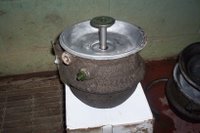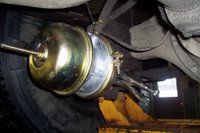AIR BRAKES-REPLACING SPRING BRAKE CHAMBERS
 Spring brakes are used for parking and are applied when air is exhausted out of the spring brake system by way of the park brake control valve on the dash. The pushrod exerts spring force on the foundation brakes until air is re-applied to the spring brake chamber to release them. This is a simple system that works very well when properly maintained.
Spring brakes are used for parking and are applied when air is exhausted out of the spring brake system by way of the park brake control valve on the dash. The pushrod exerts spring force on the foundation brakes until air is re-applied to the spring brake chamber to release them. This is a simple system that works very well when properly maintained. The spring brake pot must be CAGED when installing -for safety- with a caging bolt the spring enclosed is very powerful and deadly if it broke out of the spring brake pot. Years ago spring brake chamber diaphragms were replaceable having removeable clamps but now they are permanently enclosed so access is not allowed. I heard many stories of injuries and deaths occurring from spring brake pots letting go during servicing.
The spring brake pot must be CAGED when installing -for safety- with a caging bolt the spring enclosed is very powerful and deadly if it broke out of the spring brake pot. Years ago spring brake chamber diaphragms were replaceable having removeable clamps but now they are permanently enclosed so access is not allowed. I heard many stories of injuries and deaths occurring from spring brake pots letting go during servicing. The picture on the left shows the service side diaphragm placed in the spring brake chamber and ready for installation. There are two seperate chambers in the spring brake pot, the service side[receives normal brake application air pressure from the foot valve] and spring brake side. The service side has a removeable clamp so replacement is possible, there is no danger removing this clamp but CAGING the spring is important! the caging bolt is attached to the side of the chamber assembly.
The picture on the left shows the service side diaphragm placed in the spring brake chamber and ready for installation. There are two seperate chambers in the spring brake pot, the service side[receives normal brake application air pressure from the foot valve] and spring brake side. The service side has a removeable clamp so replacement is possible, there is no danger removing this clamp but CAGING the spring is important! the caging bolt is attached to the side of the chamber assembly.Before Removal:
I usually clamp the pushrod with brakes applied using vise grips[middle picture] so the pushrod[operates the slack adjuster] stays fully extended outside the service brake chamber and out of the way[far right picture]I also use a schraeder fitting and air chuck to air the spring chamber to retract the spring brake push rod and install the caging bolt, instead of having to manually tighten the caging bolt. Once the spring brake is CAGED and lines removed the clamp on the service side chamber can be removed and replaced along with a new diaphragm. Perform a full application using a helper and check for leaks.
When To Replace Spring Brake Pots:
Besides the obvious failures like broken springs, diaphragms leaking and spring brake not holding, there are other things you should look for: If you pull the rear plug from the spring brake pot the caging orifice on the back of the spring [where the caging bolt fits into] should be centered in the pot, if it has kicked to the side then replacement is recommended. Our shop usually change spring brake pots every 5 years as a preventive maintenance measure.
Operators are trained to perform a Tug Test: Springs on, transmission in gear, hit the throttle really quick[on and off/1000 rpm] to test the spring brake hold back. Of course the brake adjustment is relative to spring brake performance.
2 comments :
at the company I work for,they do not replace the whole can. they just replace the side that is bad. what are your thoughts on this?
shouldn't the whole chamber be replaced so your not using old side with new side?
this is bobby from Fairfax county va. I have a 1998 Thomas 3116 school bus and we have low power, slow acceleration and loose power under load. the turbo is new the fuel pressure is between 55-65 psi. we checked the air fuel ratio diaphragm and it holds 10 psi. the tube from the intake manifold to diaphragm is clear. what should the intake manifold psi be. when we applied 10 psi to the diaphragm we have vehicle on dyno and vehicle has no power issues at all. we tried hooking a bigger hose from manifold to diaphragm but has no affect. possible made worse.
Post a Comment